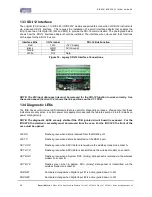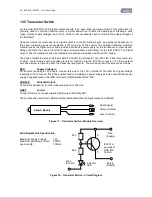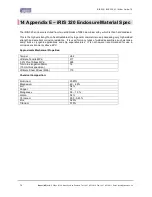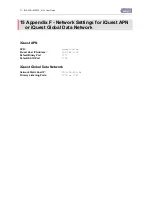
65
-
iRIS 220 / iRIS 320, V1.19 User Guide
12 Appendix C – SDI-12 (iRIS 320 / 320V only)
What is SDI-12?
SDI-12 stands for Serial Digital Interface at 1200 bps. It is a standard to interface battery powered data
recorders with microprocessor-based sensors designed for environmental data acquisition (EDA).
EDA is accomplished by means of a sensor, or sensors, and a data recorder, which collects and saves the
data. SDI-12 is a standard communications protocol, which provides a means to transfer measurements
taken by an intelligent sensor to a data recorder. An intelligent sensor typically takes a measurement, makes
computations based on the raw sensor reading, and outputs the measured data in engineering units. For
example, an SDI-12 pressure sensor may take a series of pressure measurements, average them, and then
output pressure in psi, inches of mercury, bars, millibars, or torrs. The sensor's microprocessor makes the
computations, converts sensor readings into the appropriate units, and uses the SDI-12 protocol to transfer
data to the recorder.
SDI-12 is a multi-drop interface that can communicate with multi-parameter sensors. Multi-drop means that
more than one SDI-12 sensor can be connected to a data recorder. The SDI-12 bus is capable of having ten
sensors connected to it. Having more than ten sensors, however, is possible. Some SDI-12 users connect
more than ten sensors to a single data recorder.
Multi-parameter means that a single sensor may return more than one measurement. For example, some
water quality sensors return temperature, conductivity, dissolved oxygen, pH, turbidity, and depth.
Advantages of SDI-12
A serial-digital interface is a logical choice for interfacing microprocessor-based sensors with a data recorder.
This has advantages for sensors and data recorders.
•
Unique and complex self-calibration algorithms can be done in microprocessor-based sensors.
•
Sensors can be interchanged without reprogramming the data recorder with calibration or other
information.
•
Power is supplied to sensors through the interface.
•
Hybrid circuit and surface mount technologies make it practical to include the power supply
regulator, a microprocessor, and other needed circuitry in small sensor packages.
•
Sensors can use low cost EEPROMs (electrically erasable programmable read only memory) for
calibration coefficients and other information instead of internal trimming operations.
•
The use of a standard serial interface eliminates significant complexity in the design of data
recorders.
•
Data recorders can be designed and produced independently of future sensor development.
•
SDI-12 data recorders interface with a variety of sensors.
•
SDI-12 sensors interface with a variety of data recorders.
•
Personnel trained in SDI-12 will have skills to work with a variety of SDI-12 data recorders and SDI-
12 sensors.







































